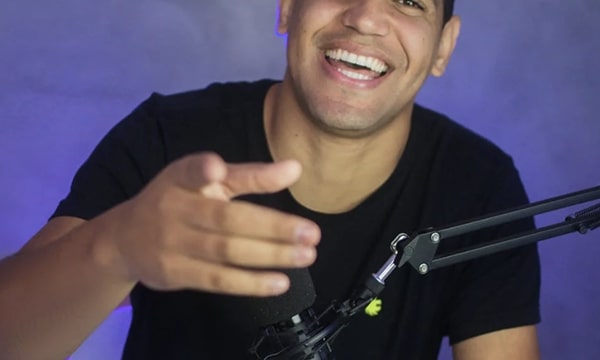 So you’ve recorded your podcast, and you’re proud of the final result. Congratulations!
So you’ve recorded your podcast, and you’re proud of the final result. Congratulations!
Now you just need people to listen to it. Thankfully, there’s more than one way for your podcast to get seen and heard. In fact, there are multiple ways to promote a podcast, and they can easily overlap to give you the best chance at being discovered. Some are pretty easy while others are more about the long game. Add one or a few to your marketing mix and see which ones have the best results.
Is your podcast polished and ready to go? Let’s start off with a few easy ones you can literally do right now:
So simple, but we can all do with an obvious reminder from time to time! All this means is including a “Subscribe” button anywhere and everywhere on your podcast. Mention it in your recording, put it on your social media and close by
Once recording and editing have been completed, decide who and where you want to submit to. The go-to is Apple podcasts, but there are up and coming players who are getting many downloads. Spotify and Google, for example. The more places your podcast is listed, the better. Plus, it’s free, so why not?
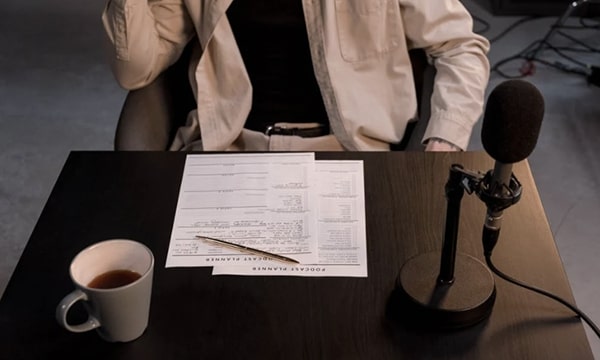 3. Maximize Existing Resources
3. Maximize Existing ResourcesDo you have an email list? Social media accounts? If not, no worries. You can create them. If you do, use them to your advantage now! Make announcements, share clips of your podcast, create posts – anything to hook people in.
(alt-tag: Angled down view of person sitting at desk with podcast notes, a mic, and cup of coffee in recording studio.)
Here are a few more ways to get ears and eyeballs on your podcast. They take a little more time and resources, but are very valuable to the success of your podcast:
Encourage listeners to ask questions and tag you on social media. That way, they get exposure, their friends get to see what they’re asking and your show gets a shoutout. People love hearing their names spoken online and this creates a loop of user engagement.
With a blog, the possibilities and shareability are endless! It’s easy to share a blog post, plus you can supercharge it with SEO words for better ranking. Furthermore, there isn’t that much of a difference between your podcast audience and blog audience, you’ll notice how they support each other to increase your audience all around.
You don’t need a fancy website, something simple will do. A website will give your blog a place to live, plus will act as a destination for your audience and leads to go to. Especially as you start building your email list, you’ll need to send them somewhere and your website is the place where they can get more information.
Your email list is like digital gold. This is your direct access point to individual members of your audience and is a fantastic way to keep people aware of your new podcast episodes, launches, subscriptions, contests, and so much more! Don’t forget to add a call to action with every email and a link to your website if you have one, or social media handles.
Instead of reinventing the wheel, get listeners listening to your show by promoting yourself on other people’s shows. Choose podcasts that have a similar audience to expose yourself to, and start making connections. Try to choose podcasts that are more famous than yours for maximum exposure!
The same applies in the opposite way. If you’re a guest on other shows, have guests on your show too. Leverage each other’s audience to grow and boost your content.
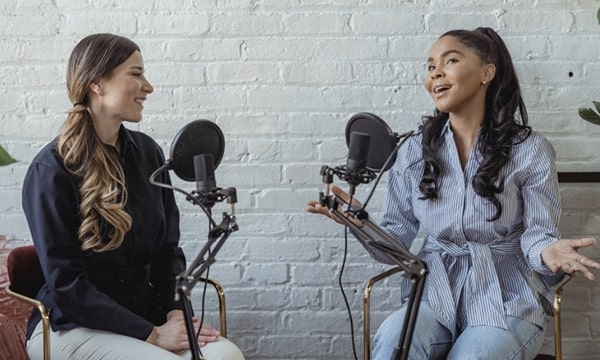 10. Contest And Giveaways
10. Contest And GiveawaysEveryone loves receiving freebies. If you’re able to give away something that aligns with your show and attracts relevant people that boost your brand instead of just the general public, consider what kind of contest or giveaway you can create. Maybe you can get people to call into your show live, or run a giveaway that invites followers to tag your show on Instagram.
(alt-tag: Two young women against a white brick background sitting separately, chatting and smiling into microphones for a podcast interview.)
Here are a few more strategies to add on top of your marketing mix. Think of these as little shortcuts and added bonuses:
With TalkShoe, you can launch your podcast into outer orbit. Enjoy a one-stop-shop for everything you need to store, distribute, syndicate, and monetize your podcast. If you want to get the most out of your podcast, learn more about TalkShoe here.
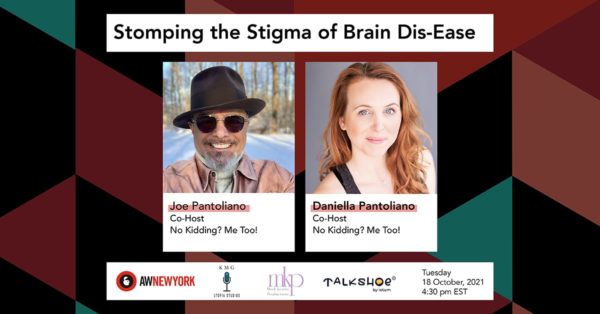 New York, NY – October 12, 2021 - KMG Utopia Studios, TalkShoe, and Mark Krantz Productions announce that award-winning actor Joe Pantoliano and his daughter Daniella Pantoliano will kick off season two of their popular podcast, “No Kidding? Me Too!”, at Advertising Week NY 2021 with a live Q&A on Monday, October 18th at 4:30 pm ET and a virtual session on Tuesday, October 19th at 2:00 pm ET.
New York, NY – October 12, 2021 - KMG Utopia Studios, TalkShoe, and Mark Krantz Productions announce that award-winning actor Joe Pantoliano and his daughter Daniella Pantoliano will kick off season two of their popular podcast, “No Kidding? Me Too!”, at Advertising Week NY 2021 with a live Q&A on Monday, October 18th at 4:30 pm ET and a virtual session on Tuesday, October 19th at 2:00 pm ET.
Joe and Daniella will conduct a lively and intimate interview with Kelly Carlin, author, performer, and life coach. Growing up as the only child of comic legend George Carlin, Kelly will share her family's struggle with mental health, addiction, and healing.
This season will continue the candid and revealing conversations with familiar and important names in the entertainment and mental health fields, including comedian Lewis Black, former NFL player Michael Oher, New York Times columnist Dr. Jen Gunter, and mental health advocate and son of Robin Williams, Zak Williams. The podcast examines “Emotional Dis-Ease” and how to cope with day-to-day life and the blurry line between creativity and madness: “It’s ok not to be ok.”
“We are thrilled to bring this important conversation to Advertising Week,” said Joe Pantoliano. “It is important for us to collaborate with brands and advertisers on the increasing intensity of brain Dis-Ease, the co-occurring nature of addiction, and how to discover a recovery process. This is a perfect opportunity to raise the volume on recovery.”
“This is a great opportunity to bring the essence of ‘No Kidding? Me Too!’ to the advertising community,” remarked Daniella Pantoliano. “We can show them in ‘real time’ how we address the issues surrounding ‘Emotional Dis-ease’ in a uniquely compelling, funny, and entertaining way.”
(Bad Boys Trilogy, The Matrix, Memento, Bound, and an Emmy win for The Sopranos), Joe Pantoliano has become a significant voice in the area of emotional health. He has traveled the world with his Award-winning documentary No Kidding? Me Too! as part of his advocacy of stomping the stigma, shame, and discrimination of “emotional Dis-Ease.” Joe uses celebrity to shine a light on what 100 million Americans suffer in isolation.
Daniella Pantoliano is a filmmaker. Currently, she is a writer, director, and cinematographer for the Brooklyn-based company Reelarc. Daniella wanted to start this podcast to feel less alone in her emotional trauma and Dis-Ease. Also, this seems like a better option than going to therapy with her father, as he is too cheap to pay for it, and this way they get to have a buffer. Daniella’s greatest wish is that this podcast will encourage listeners to be vulnerable and intimately share with loved ones the important conversations about emotions, trauma and just getting through the day.
KMG is a leading New York City-based advisory business development and content syndication firm that provides critical direction on issues of content syndication, marketing, advertising, media, entertainment, and digital technology. In 2020 KMG launched KMG Utopia Podcast Studios, distributing “The Fred Minnick Show”, Politicon’s “How the Heck Are We Gonna Get Along, Ditty TV Podcasts, and Eye on Travel with Peter Greenberg. KMG Utopia formed a joint venture with the Talkshoe Podcast Platform in 2020.
Founded in 2016, Talkshoe was the first community-based podcast hosting, recording, and storage platform that allowed users to host or participate in live podcasts. TalkShoe was acquired by iotum in 2016 and will be relaunched in late 2021. The new TalkShoe will offer a superior audio & video hosting platform with state-of-the-art publishing, analytics, and monetization tools. From hosting to creation, distribution, marketing, and beyond, TalkShoe will have every facet of production covered.
Based in New York, Mark Krantz Productions produces live events, television specials, and cause-related properties for a variety of clients. Mark Krantz is a creator of The Kennedy Center Mark Twain Prize as well as The Library of Congress Gershwin Prize for Popular Song.
For Krantz Media Group:
Gary Krantz
646-573-6800
gkrantz@krantzmediagroup.com
For Mark Krantz Productions
Mark Krantz
Mark Krantz Productions
917-913-5979 m.krantz@mkpny.com
Podcasts are mostly an auditory experience. Connecting with your audience is accomplished by creating episodes that feature voices, sound bites and clips, audio signatures, jingles, sound effects and any other audio feature that enhances the podcast. The words exchanged are valuable and make people want to listen (or not listen) to your podcast.
While podcasts are thoroughly audio, there is one visual aspect that can’t be swept under the rug and that’s podcast cover art. In fact, the success of your show might even depend on it. Of course quality podcast content is king, but shortly after, it’s your cover art that draws in curious eyeballs.
Here’s what you need to know about creating compelling podcast artwork so you can make it right the first time without having to go back to the drawing board.
 Understand Restrictions And Requirements
Understand Restrictions And Requirements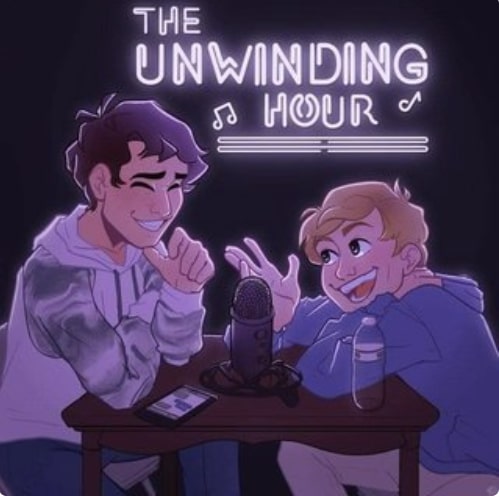 Select Appropriate Typography
Select Appropriate Typography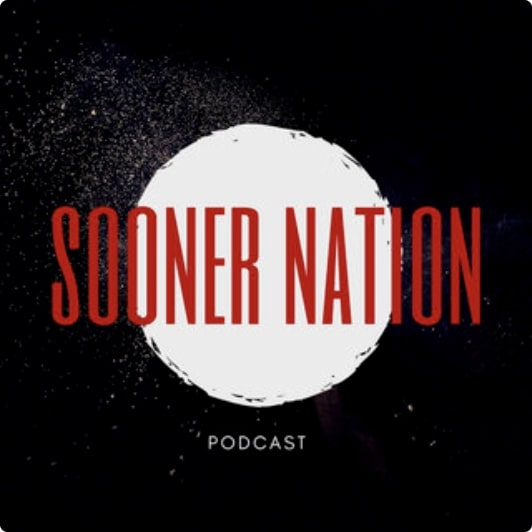 Get Marketing
Get MarketingTrust TalkShoe to provide you the tools and support you need to host, produce and store a knockout podcast. Create professional-sounding episodes and experience what it’s like to broaden your audience with the analytics tools that bolster your reach. Plus, with TalkShoe’s virtual recording studio, you can produce high quality content that listeners from near and far want to listen to.
It’s easy to record a podcast with guests remotely anywhere they are, no matter where you are. Learn more about TalkShoe here.
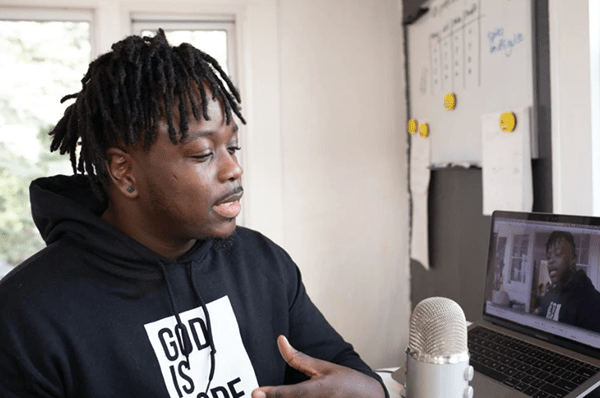 Remote interviews, co-hosts overseas, collaboration across town; When it comes to creating an entertaining and informative podcast, thanks to technology, there’s no limit to what you can do! Furthermore, with advances in podcasting pushing the edge of popularity and reach, podcasters have choices when it comes to recording in person or from afar.
Remote interviews, co-hosts overseas, collaboration across town; When it comes to creating an entertaining and informative podcast, thanks to technology, there’s no limit to what you can do! Furthermore, with advances in podcasting pushing the edge of popularity and reach, podcasters have choices when it comes to recording in person or from afar.
Curious to know more about how to record a podcast with guests remotely? Read on for a few nuggets of wisdom to get you sorted before, during and after your session.
Whether you’re used to recording IRL or you’re starting to think about starting a podcast, you might be wondering a few questions:
Set yourself up for a flawless podcast recording by investing in the best tools and accessories you can afford. Here are a few essentials no podcaster should be without!
Microphone
Your device’s built-in speakers and mic are fine for casual use, but when producing a high quality sound, it’s just not good enough. You want your audio to be as smooth sounding as possible – otherwise who’s going to listen?
Instead, go for a USB mic (excellent for beginners) or spring for an XLR mic that will really deliver crisp and clear sounding audio.
Headphones
Second to a good mic, a proper headset will deliver sound with minimal feedback and is necessary for you, your guests and or co-hosts. Even earbuds will work, but if you want to have a dedicated set, it’s extra helpful to have headphones that allow you to adjust the sound as you move along, when you can adjust the distance between your mic, or turn up the volume.
Space
Sure a perfectly soundproofed recording studio would be ideal, but that’s not always possible. Instead, make small adjustments that can vastly improve the quality of your recording:
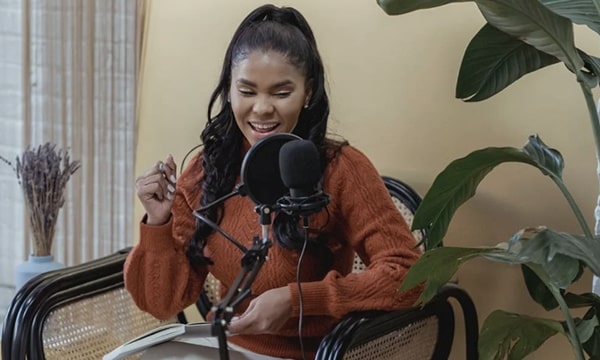 Lively Guests
Lively Guests
Part of a great recording is the ability to create a fun and entertaining environment for guests so they feel comfortable enough to relax and open up. A set of thoughtful questions, already-researched stats and quotes and of course, choosing the right guests to match the energy of your show will all come together to create podcasting magic!
Try matchmaker.fm to connect you to a community of other like-minded individuals who can add depth and dimension to your interview or podcast episode.
When recording your podcast remotely, choose software that has the ability to record high quality sound using a virtual recording studio. A virtual recording studio allows for multiple people to be connected to each other to work and collaborate in an online space. There’s no need to interview in real life or sit beside your co-host in a four-walled room.
Pro-tip: Recording video alongside audio provides you with more options for content down the line. Perfect for social media and YouTube, a video recording of your podcast gives listeners turned viewers a behind-the-scenes look at what’s happening when you record your podcast. Plus, you can make bite-sized clips for marketing and advertising purposes too!
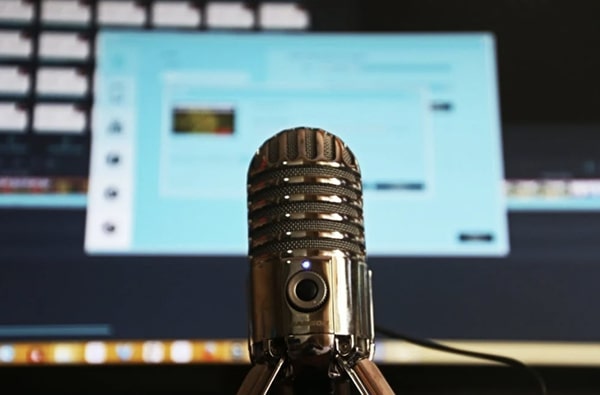 Instead, a virtual recording studio provides all the same benefits and features, but lives online, providing you with everything you need to record, edit and produce your podcast from wherever you and your counterparts are.
Instead, a virtual recording studio provides all the same benefits and features, but lives online, providing you with everything you need to record, edit and produce your podcast from wherever you and your counterparts are.
Make use of features that enrich the quality of your podcast like screen sharing that brings others onto your screen for navigation in real-time and better collaboration; record locally using 1080p video and crystal clear audio for a sharp viewing and sound experience; live stream to YouTube and share your unique URL so people can watch you in real-time; and producer mode controls that adjust settings and modes for optimized viewing.
Once you’ve pulled off a successful podcast and stopped recording, this is where editing and the final touches that will make your podcast shine come into play. In the virtual recording studio, you can connect and collaborate with other producers or editors (or work solo!) to really make your final cut a masterpiece!
Here’s the best part: You can choose to work from your masterfile (the finalized file comprising all audio or video tracks as one) or individual files (the masterfile separated into multiple tracks: audio and video) to edit together an ultra clear sounding podcast without scratches, and poor sounding background noise. Plus, if you choose to record video, you have a video file to work with for social media content!
With TalkShoe, you can create professional podcasts whether you’re a seasoned expert or brand new to the game. Experience what it’s like to record and stream, export and import and host and store your podcast with ease.
Plus, with TalkShoe’s virtual recording studio, you can produce high quality content that listeners from near and far want to listen to. Bring in guests to host engaging interviews, co-host from anywhere and do all your producing, editing and storing in one place; in the virtual recording studio that comes loaded with online recording features, the ability to mix through virtual consoles plus virtual gear and other industry-leading tools to shape how your podcast comes together!
It’s easy to record a podcast with guests remotely anywhere they are, no matter where you are. Learn more about TalkShoe here.
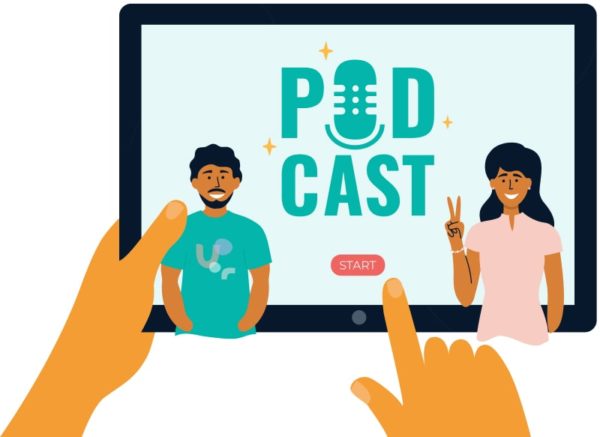 As we know, podcasts are rapidly growing as a medium in recent years. In 2018 Apple and FastCompany stated that there were over 525,000 podcasts all over the world. Today? It’s over 2 million podcast shows with more than 48 million episodes in total, showing a very rapid growth in just three years.
As we know, podcasts are rapidly growing as a medium in recent years. In 2018 Apple and FastCompany stated that there were over 525,000 podcasts all over the world. Today? It’s over 2 million podcast shows with more than 48 million episodes in total, showing a very rapid growth in just three years.
In today’s very fast-paced, knowledge-hungry society, podcasts offer a significant benefit over other primary mediums like text-based content and videos: we can listen to podcasts while doing other activities since we don’t use our eyes. It’s, for example, dangerous to read a blog post or watch a YouTube video while driving or when lifting the dumbbell in the gym, but that’s not the case with podcasts.
We are shifting from “seeing is believing” to “hearing is knowing”: podcasts offer a chance for us to consume information, gain valuable knowledge, and even learn new skills anytime and anywhere.
This is why over half of American homes nowadays are actively listening to podcasts and over 20% of the American population tune in at least once every week.
With that being said, it’s definitely a great time if you are currently looking to start a podcast, but many people are discouraged because they simply don’t know where to start.
If you are currently in that situation, you are definitely not alone, and you’ve come to the right place.
In this guide, we will discuss:
And more.
So, without further ado, let’s get started right away.
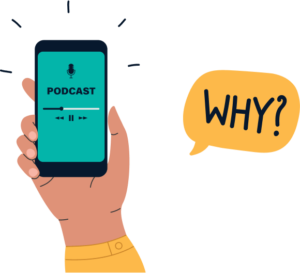 Why do you want to start a podcast in the first place?
Why do you want to start a podcast in the first place?
There can be various valid reasons here. Probably you are simply looking to get famous and hopefully, the show will go viral. This is a perfectly valid reason. Or, maybe you already have an established business and you want to start a podcast to support the business by engaging your target audience with valuable content.
Or, probably you are simply good at something and just want to share your knowledge with your audience.
It’s important to first identify your reason. Not only can it help you in deciding which audience to target and what kind of podcast show to create, keeping your “why” in mind can help you stay motivated throughout the potentially rough journey.
A common misconception is to think that only people and businesses that already have an audience (at least a few) are capable of starting a successful podcast show.
While this certainly can help, many successful podcasters start from nothing with literally 0 audiences. Many people simply don’t care if they’ve never heard of you before if your podcast episode seems interesting.
However, if you already have a bit of an audience (or a lot), then you can analyze your existing audience as the basis of your podcast’s planning stage. Figure out their demographics data, location, interests, behaviors, and pain points. You can conduct surveys and/or interviews where you can also ask what other podcast shows (if any) they often listen to.
Above anything else, it’s crucial to figure out who your podcast is for when planning the show and its content. You need to give your target audience a reason to listen to your podcast. We’ll discuss more of this in the next step.
Design a reason why people will listen to your podcast, which can be:
And more. Your imagination is the only limit.
It’s crucial not only to give your target audience a reason to listen to your episode but also how to keep them back for more.
A great way to start is to write down a list of 10 to 20 potential episodes while considering the selling point of each.
The next step is to decide on a show name. You’ll need a catchy name that is attractive to your target audience, but also easy to remember.
There are several different approaches to consider when naming your podcast show:
A relatively boring but effective approach is to simply call your show with a descriptive name that your audience will search for. For example, if your show will cover film reviews, you can call it something along the line of “The Film Critics”.
In this approach, you’re going to give your podcast show a unique and potentially catchy name.
There are various techniques we can use here, for example by using portmanteau words (a fusion of two words or parts of words). However, if you use a unique name, it’s also crucial to make sure your target audience can find the show with common search phrases. A common approach is to give the show a descriptive tagline or subtitle.
For example, we can name a sci-fi enthusiast podcast “StarJunkie: All About Sci-Fi”.
If you’ve already got a substantial amount of audience, then you can leverage this fact and use your name or your brand name for the podcast. You can also combine this with the other two approaches, for example with a descriptive name like “Science Talk with John Doe”.
The good news is, nowadays you don’t really need expensive equipment to start recording your podcast.
If you have a working computer/laptop, a USB microphone (which is very affordable nowadays), and internet access, then you are basically good to go. Obviously a more expensive and complete setup can provide better sound and production quality, but you can create a pretty decent show with just this bare minimum setup.
If you have more budget, you can consider more expensive microphones, a mixer, and other pieces of equipment. Here are some podcasting tools and equipment to consider:
We’ve discussed that you can basically start recording your podcast with just a computer and USB microphone. Yet, what should you do once you plug the USB microphone into the computer?
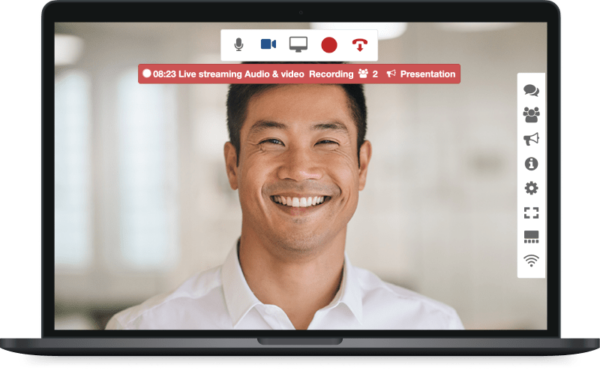 This is where the software tools will do their job.
This is where the software tools will do their job.
Basically, you’ll need the help of software solutions in three key areas:
With TalkShoe as an all-in-one podcasting solution, you get all three functions in a single software, so you don’t have to worry about moving between different tools and importing or exporting files, which is often a hassle.
A common misconception when discussing how to start a podcast is that we upload the podcast directly to channels like Spotify or iTunes, but that isn’t actually the case. Instead, we’ll need a hosting service to host the audio files. The hosting service will then distribute the podcast to relevant channels.
TalkShoe is also a comprehensive podcast hosting service so you can record, edit, and publish your shows in a single dashboard.
Another key consideration when choosing your podcast software is the capability of generating an RSS feed. For podcasts, an RSS feed is crucial since podcast episodes are syndicated and distributed through RSS. Think of the RSS as your podcast show’s URL.
While it’s possible to code your own podcast feed, having a platform like TalkShoe that can automatically provide your podcast’s own RSS feed can take the hassle of coding your own from your podcast production process.
With the RSS code provided upon signing up to TalkShoe, your podcast is immediately available across multiple popular channels like Spotify, Apple Podcast/iTunes, and more. You don’t need any programming knowledge and can focus on what matters: your show’s content.
In this day and age where Zoom is the norm, live podcasting is now a popular thing, and if you plan to host live episodes, you’ll need to get the right software solution that will enable you to do so.
TalkShoe offers a live virtual studio, allowing you to invite guests and co-hosts to your live podcasts easily via a functional video conferencing function. Your guests and/or co-hosts can easily join the live podcast from any device, and you can easily invite guests via email, SMS, or even by simply sending your virtual studio’s URL.
Within the virtual studio, you can start and stop recording seamlessly. This is useful in online real-time recording situations since this means you can pause the show when there are any delays or issues with your guest’s connection, and resume the show again when you are ready to record.
While there are many purists that would argue that podcasts should be audio-only, we can’t deny the fact that many popular podcasts have successfully cross-list the podcast videos in video formats on YouTube and other platforms.
If you want to do this, again, you’ll need a software solution that allows you to also record videos. TalkShoe not only lets you record video along with your audio data but also directly live broadcast your episode to YouTube. This is a great way to expand your audience.
We all know one of the biggest challenges in running a podcast show is how to market your show to attract more listeners.
Here are a few actionable tips you can try:
Carefully consider what words and phrases your potential listeners would type into a Google search or the search bar of Spotify, iTunes, or other podcast streaming services.
Use these keywords in your title and show description. Refer back to the naming section above on how to create unique podcast names that are also optimized for search keywords.
Your show’s and episodes’ descriptions will be the main reason potential listeners click (or don’t click) and listen to the show. So, it’s crucial to write descriptions that are attractive for your listeners, but at the same time only giving just enough information to leave them hanging. Don’t forget to include your target keywords and relevant links.
Fairly obvious, social media is where everyone is nowadays, so it would only make sense to market your podcast on key social media channels like Facebook, Instagram, and Twitter. Also, don’t underestimate LinkedIn especially if your podcast is targeting professionals and businesses.
Be active on your social media accounts, and use the paid promotion options strategically.
Beyond your episode descriptions, consider including show notes or even full transcriptions of your show. A full transcript can actually be useful for SEO, and services like TalkShoe can help in this aspect by automatically generating a transcript.
Don’t treat other podcasts as competitors, but reach out to them and find opportunities for collaborations and cross-promotions. Be a guest on other shows, and recommend other podcasts in your show and vice versa.
By following the tips and tricks we’ve shared above, you are now ready to create a successful podcast and attract a lot of listeners.
While planning and building a successful podcast takes patience and practice, platforms like
TalkShoe can give you all the help you’ll need throughout the exciting journey. Our community-building podcast platform has all the essential features you’ll need: free unlimited storage, automated RSS feed generation, all-in-one recording and editing functions.
Your voice is literally just episodes away from being heard by your listeners.
 Whether you’re getting together your first or 100th podcast episode, knowing how to write a podcast script will ensure your show is a hit. Writing out your thoughts, cues, important information, interview questions and prompts in a cohesive flow sets the tone and paves the way for a podcast you can lead without worrying about dead air or lack of conversation.
Whether you’re getting together your first or 100th podcast episode, knowing how to write a podcast script will ensure your show is a hit. Writing out your thoughts, cues, important information, interview questions and prompts in a cohesive flow sets the tone and paves the way for a podcast you can lead without worrying about dead air or lack of conversation.
A podcast script also saves you time when editing after you’ve recorded. The script acts as a structure, as well as a support and reference if you find you’ve lost your way or train of thought. A script gives you peace of mind, so you know you won’t run out of things to say!
Here’s how to write a podcast script:
One of the most important things to remember while writing a podcast script is that people will be listening intently to your words. If you write the script and read it off word for word, your audience will be able to detect it. A natural, conversational rhythm is what sounds the best, otherwise, it’s too formal and comes across as contrived and rigid.
Support the direction of your script and veer away from formality by injecting your own personality. You don’t have to get caught up on the exact verbiage, the perfect word or the precise cadence. Instead, choose sayings and metaphors and throw in a joke now and again, only if it serves your purpose and enhances your message.
Choose from a few different podcast styles depending on your message and what your audience likes. Stick to one, or experiment to find what works best for you:
The most popular type of podcast, an informational podcast, tends to require a detailed script. Introducing the topic, teaching listeners about it then presenting facts, anecdotes and statistics need to be held up by pre-planned thoughts and content research. This type of podcast can be long form (up to 90 minutes) or be presented in smaller, more digestible chunks (5-30 minutes).
Relying on a detailed script in this case provides the foundation for an entertaining podcast that is accurate and rich in well-presented and documented information.
A conversation or interview might sound natural and off the cuff (which is a good sign!) but is normally pretty planned and thought out ahead of time. If a conversation sounds flowy, that means the host and guest are doing an excellent job at referring to their script!
 Pro-tip: It’s good to stay on track in this style so you don’t have to spend too much time editing later. That being said, you also don’t have to go too much into detail. You can include bullet points of topics and questions to cover, and have some extra ideas on hand.
Pro-tip: It’s good to stay on track in this style so you don’t have to spend too much time editing later. That being said, you also don’t have to go too much into detail. You can include bullet points of topics and questions to cover, and have some extra ideas on hand.
In an interview scenario, it’s also a great idea to be well-versed with the guest. Who are they? What’s their elevator pitch? What are they on the show for? Do they have a new book out, movie, appearance, accolade? What topics of conversation will shine the best light on them?
Not all podcasts have to be so educational! In fact, a lot are theatrical and entertaining for listeners. To some degree, improvisation is encouraged, but depending on the experience of the podcaster, scripting might be a necessary means of delivery. Ask yourself: Do you prefer reading a pre-written piece, or can you jot down ideas and fill in the gaps from there?
Every podcast will naturally ebb and flow and change according to the content and podcaster, however, following a basic template can align your ideas and content into a simple structure:
 Here are a few more helpful tips for how to write a podcast script that sounds professional and works for your listeners:
Here are a few more helpful tips for how to write a podcast script that sounds professional and works for your listeners:
Join TalkShoe, an easy-to-use, reliable and all-in-one podcasting platform that caters to a community of podcasters. Create professional-sounding podcasts fast and effectively. No previous experience required! Get your message out there and your podcast heard by your audience, near or far. Sign up with TalkShoe today.
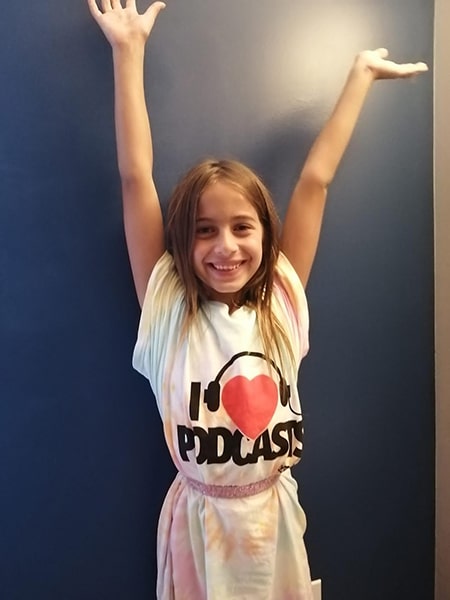 Every summer, Podcast Movement, the world’s largest podcast conference, attracts thousands of talented podcasters and leading professionals from every corner of the world to come together to share, grow and evolve. After a year hiatus, Podcast Movement 2021 in Nashville was bigger, brighter and came back fiercer than ever before – and TalkShoe was there for every step of the way!
Every summer, Podcast Movement, the world’s largest podcast conference, attracts thousands of talented podcasters and leading professionals from every corner of the world to come together to share, grow and evolve. After a year hiatus, Podcast Movement 2021 in Nashville was bigger, brighter and came back fiercer than ever before – and TalkShoe was there for every step of the way!
At Podcast Movement 2021, we got a world class education and got to network with the best. We got to connect with brands and meet hundreds of companies from all over. We rubbed shoulders with industry movers and shakers at some of the more low-key gatherings as well as the upscale parties...this is Nashville after all!
TalkShoe got to pair up with co-venture partners Krantz Media to talk to podcasters and producers to find out what they want and need in a podcasting platform. Not only did we get to showcase TalkShoe as a living and breathing brand, we got to size up the competition! We attended multiple keynotes, and presentations and stuck around to see Mark Cuban work his magic for the crowd!
Of all the product launches, demonstrations, lectures and press chats, one of the most interesting things we learned is that podcasters need help with marketing. While the technology is there to produce, stream and store content (hello TalkShoe), the game changer for podcasters both new and experienced is including a marketing plan that will elevate their offering and get them seen...and that’s good news for us! TalkShoe’s new platform has been redeveloped to be even easier and more straightforward to host, record, produce and edit high quality podcasting content.
Curious to know more? Sign up here.
Other TalkShoe highlights from Podcast Movement 2021 in Nashville include:

Meeting up with a few fellow Canadians from Quill IT. We got to catch up and talk shop while also doing relationship management. @podcastmovement @quill.inc

The full TalkShoe team with Gary Krantz, Founder and CEO of Krantz Media Group, who we’ve been working with for months!
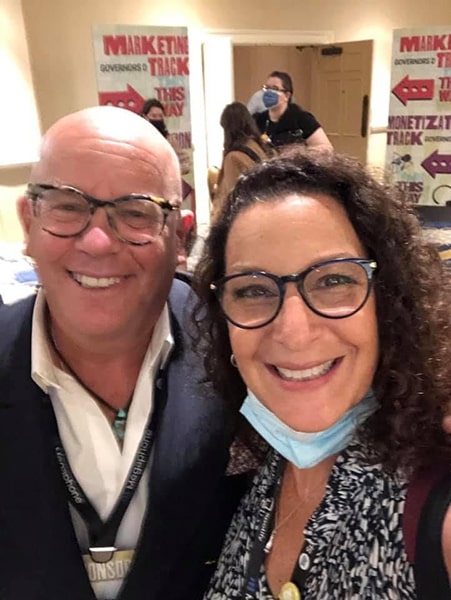 A behind-the-scenes selfie with Gary Krantz and E.B. Moss, Founder of Moss Appeal branding and marketing consulting for podcasts, social media and sustainable marketing. @gkrantz @quitealiving
A behind-the-scenes selfie with Gary Krantz and E.B. Moss, Founder of Moss Appeal branding and marketing consulting for podcasts, social media and sustainable marketing. @gkrantz @quitealiving
And that’s a wrap! TalkShoe came, saw and conquered Podcast Movement 2021, Nashville.
If you’re looking to add a whole other dimension to your podcast, whether it’s your first episode of your hundredth, here’s how to to kick up a storm with your podcast; The new TalkShoe is coming this fall, and as an early adopter, you can gain special partnership and monetization opportunities.
Built specifically for podcasters and producers, you can host and store, distribute and syndicate and easily transcribe your podcast on TalkShoe’s audio and video hosting platform. It’s your podcast, your way.
Sign up for early access to TalkShoe’s new platform and to stay on top of release dates, marketing bonuses and more!
 When it comes to marketing a podcast, there are truly no limits to what you can create. The landscape is continually shifting and evolving with an ever-expanding list of new mediums, platforms and concepts to experiment with.
When it comes to marketing a podcast, there are truly no limits to what you can create. The landscape is continually shifting and evolving with an ever-expanding list of new mediums, platforms and concepts to experiment with.
Thinking outside the box will always be rewarded, so don’t be afraid to color outside the lines here and there. Coming up with new and exciting ways to promote your podcast is all part of the fun, so roll up your sleeves, get crafty and try out some new tactics. Be careful what you wish for—they just might work!
But first, get a leg up on the competition and make sure you aren’t missing out on any key opportunities. Here are five things most podcasters overlook when it comes to growth:
Gone are the days of one-sided monologues that don’t allow the audience to weigh in. Your podcast and all its associated marketing channels should be more of an interactive dialogue that welcomes audience feedback, suggestions and perspectives.
You could be doing everything right marketing-wise, but if you’re not taking the time to really connect with your audience, you’ll be missing out on a great chance to win over lifelong followers. The good news is that there are plenty of creative ways to interact with your audience and create a community surrounding your podcast.
 Here are just a few ideas for engaging listeners in the fun and being more of a proactive podcaster:
Here are just a few ideas for engaging listeners in the fun and being more of a proactive podcaster:
Livestreaming. In addition to releasing regular pre-recorded podcast episodes, going live on Facebook or Instagram to answer questions in real time can be a great way to build trust with your followers and engage them about your specific topic or area of focus.
Audience polls. What’s the best way to find out what your audience wants content-wise? Just ask! Asking questions or conducting surveys through Instagram or your e-newsletter can be a great way to figure out what’s working well for your brand and what needs some rejigging. As long as you’re engaging with your followers in a meaningful way, they’ll gain trust in you over time and feel like their opinions are valued.
Events. Hosting an event, whether virtual or in-person (provided it’s COVID-safe), is a great way to engage with your audience, meet like-minded people in your industry and continue fostering a sense of community among your followers. Even hosting a casual weekly webinar at the same time each week can help you grow your network and add an interactive element to your brand.
One of the best ways to turn up the volume on your podcast and make sure you’re maximizing listeners is to submit your show to as many podcast directories as possible. In addition to submitting your RSS feed to major listening apps like Apple Podcasts, Spotify, or Google Podcasts, expand your reach to other directories or “podcatchers” as they call them in the biz.
There are dozens of podcatchers out there that can expose your show to a broader listener base and ultimately help you gain subscribers. Here are some examples of podcast directories that aren’t talked about as often but are still effective:
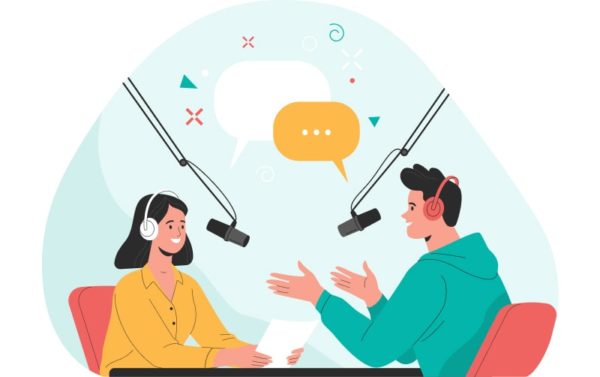 Although other podcasters are technically “the competition,” the podcasting world is all one big happy family at the end of the day. Working together is more effective (and fun!) than creating alone in a silo, so don’t hesitate to reach out and make some new friends. Collaborating with other podcasts operating in a similar space to you can help both of you boost your followings and gain exposure to new potential listeners.
Although other podcasters are technically “the competition,” the podcasting world is all one big happy family at the end of the day. Working together is more effective (and fun!) than creating alone in a silo, so don’t hesitate to reach out and make some new friends. Collaborating with other podcasts operating in a similar space to you can help both of you boost your followings and gain exposure to new potential listeners.
There are plenty of creative ways to collaborate with another podcaster, but it doesn’t have to be complicated. Sharing a simple tweet or Instagram story to shout out each other’s accounts is an easy yet effective way to grow your audience in no time.
Here are some ideas for ways to collaborate with your fellow creators:
While everyone knows that social media is where it’s at these days, some creators tend to overlook lesser-known platforms in favor of focusing solely on the typical Facebook, Twitter and Instagram deal. It’s definitely important to upkeep these more mainstream channels, but while you’re at it, try looking into other platforms and online forums like Quora or Reddit to continue building your community and tap into a more niche audience.
If you’re going to experiment with online forums, make sure to add value with every post and contribute to conversations authentically as you would IRL. Try to avoid sounding salesy or like you’re pushing a product, and only add to the threads you’re genuinely interested in or knowledgeable about.
Here are some more off-the-beaten-path platforms to check out if you’re looking to explore:
Clubhouse
WattPad
Twitch
Influenster
SoundCloud
In the early stages of their journey, many podcasters overlook the importance of getting into a steady rhythm of content creation. Consistency is key in any discipline, and podcasting is no exception. Leaving too much time between episodes or releasing content in spurts could confuse your listeners, whereas releasing new episodes on the same day each week gives them something to look forward to and will ultimately contribute to your growth overtime.
 These days, it seems like every brand has a podcast—no matter the industry, subject matter or area of expertise. With so many online resources and podcast production tools at our fingertips, it’s easier than ever to figure out how to start a podcast, but does that mean it’s the right move for everyone?
These days, it seems like every brand has a podcast—no matter the industry, subject matter or area of expertise. With so many online resources and podcast production tools at our fingertips, it’s easier than ever to figure out how to start a podcast, but does that mean it’s the right move for everyone?
Podcasting is an accessible medium that anyone can learn to use effectively, so there’s no harm in experimenting with a podcast of your own. The only reason you might want to think twice about starting a podcast is if it doesn’t seem like an appealing idea to you, but even then, you can always outsource the work to people who are passionate about podcasting (as long as you’re passionate about the subject matter).
There’s no downside to launching a podcast as an extension of your brand because at the very least, it can serve as a fascinating branding exercise that will ultimately help you enrich your key messaging and dive deeper into your topic. If you’re still looking for a reason to get started, here are 10 signs your brand might be ready for a podcast:
Whether you’ve achieved a PhD or written a successful book about your subject, if you can confidently call yourself an expert, a podcast may be in your future. Even if you haven’t reached any big milestones in your area, you may feel like you’ve garnered enough knowledge over the years to speak about it for hours, which is a sure sign you’d be great at podcasting.
With podcasting, you have the unique opportunity to chat about your subject for upwards of an hour, which presents an easy and effective way for brands to tell their stories and connect with listeners. If you have a strong brand story or message you’d like to get across to your audience, a podcast would be the best place to start.
Do you often find yourself lost in conversation with people who are interested in the same things as you? You might want to turn that passion into profit by hitting ‘record’ before your next chat session (well, it involves a little more work than that, but you get the idea!).
 4. You’re well-spoken by nature.
4. You’re well-spoken by nature.Podcasting is an auditory platform, so if you tend to shy away from writing but speaking is your jam, a podcast may be the right fit for you. Put that gift of gab to good use and share your knowledge far and wide. Even if you don’t consider yourself a natural speaker, there are plenty of ways you can work on improving your voice and tone overtime.
While there’s nothing wrong with launching a podcast at the same time as your company, it could be wise to leave a little buffer time so you can really nail down your brand messaging before branching off into new mediums. Take some time to drill down on your company’s values, ideologies and area of focus so you and your audience are crystal clear on what you’re all about.
If you’ve never launched a podcast before, you’ll likely run into a bit of a learning curve as you dive in. While you probably already have plenty of transferable skills that can be applied to podcasting, you’ll need to learn about new tools, platforms and software apps to help you make your show the best it can be. A willingness to learn and consistently improve can take you far in the podcast industry (or any industry, for that matter!).
While this isn’t necessarily a requirement for starting a podcast, research skills can really come in handy during the process of planning and writing episodes. Diving deep into a topic and pulling out interesting tidbits can be a great way to add some colour to your script and entice listeners.
If you answered “yes” to number three on this list, you’ll likely be enthusiastic about featuring guests on your podcast. Again, featuring guest interviews isn’t a hard-and-fast requirement, (hint: there are no hard-and-fast requirements when it comes to podcasting!) but speaking to leaders, innovators or changemakers in your space can be a great way to showcase new and interesting perspectives on your topic.
Creating a podcast about a niche topic not many people are talking about is definitely a viable option, but it’s also not a bad sign if there’s already some buzz online about your topic. We’re supporters of getting more specific with whatever topics you cover, but with that being said, you don’t want to go so niche that you have a total of five listeners that can relate to your subject matter. So overall, it’s always safe to select a topic that will stand out from the crowd but also tap into a significant audience segment.
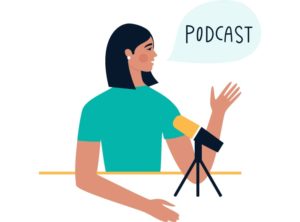 10. You’re willing to put in the work.
10. You’re willing to put in the work.With great podcasts comes great responsibility. Just kidding, but if you’re planning on launching a podcast, you’ll need to put in some effort to stay consistent with your goals and continue growing through communications tactics like social media, newsletters, blogs and more. You can always hire an agency to help you out, but at the end of the day, behind every successful podcast there’s at least one passionate person working overtime to make it happen.
Mackenzie Patterson is Quill Inc.’s digital content strategist.
Creating your brand’s overall marketing strategy is like putting together pieces of a puzzle. It involves creative thinking, taking risks and plenty of trials until you can get the formula just right.
In the age of information, brands have access to a full-blown buffet of tactics at their fingertips—from podcast marketing to experiential events. However, going full throttle and taking advantage of all of them at once isn’t always the wisest strategy.
Audiences and consumers are smarter and savvier than ever before. They can tell when a brand isn’t being authentic to its mission, values and voice, so throwing every marketing tactic at the wall and seeing what sticks probably won’t get you the best results.
You don’t have to use every trick in the book to tell your brand’s story in an effective and engaging way. So how do you know which tactics are best for your brand?
When it comes to podcasting, there’s really no downside to starting a podcast as an extension of your brand. While other tactics like promotional events or advertising campaigns may cost you thousands of dollars, podcasting is technically free to start (more on this later), so you have nothing to lose if you want to give it a go.
If you’re still on the fence about starting a podcast, here are a few questions to consider that may help solidify your decision:
In case you haven’t heard, podcasting is an auditory medium used to tell stories, start conversations and discuss anything from baking bread to murder mysteries. It may seem obvious, but the best reason to start a podcast is because you have a strong message you really want to get across to listeners.
Since podcasts have become so wildly popular, some brands have been hopping on the bandwagon before thinking about their core message and why they want to start a podcast in the first place. Everyone has a story to tell, but it’s important to be strategic about the particular vehicles you choose to spin your brand’s narrative.
You wouldn’t stand up and yell “listen up, everyone!” at the dinner table if you had nothing important to say, so why would you start a podcast without a strong overarching message to convey? Before launching a podcast as a marketing tactic, make sure you’ve done the work to determine what it is you’re trying to say through your podcast and why.
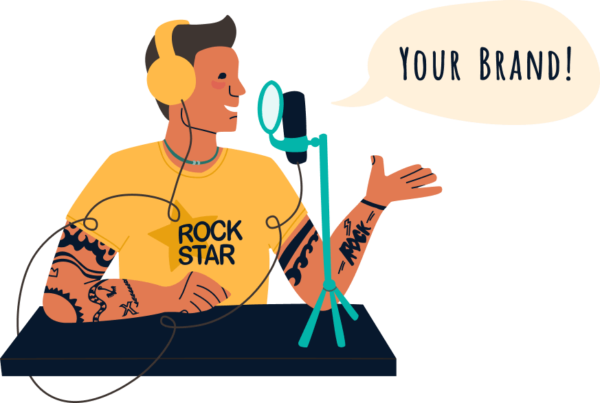 Once you’ve established the mission and messaging for your podcast, take some time to consider your ideal audience base. If you’ve already determined your overall target audience for your brand or business, then this should be a breeze.
Once you’ve established the mission and messaging for your podcast, take some time to consider your ideal audience base. If you’ve already determined your overall target audience for your brand or business, then this should be a breeze.
However, you may want to consider broadening your audience so you can reach more potential listeners and eventually convert them to clients or customers. Consider which demographics you risk alienating with your content—for example, a podcast about vegan living may turn away meat-eating listeners.
Whatever you decide, make sure you’re intentional about your choices and you know the kind of listeners you’re trying to reach as your end goal. This will help the content creation process flow much more organically because you’ll be writing each episode with a target audience in mind.
While podcasting is technically a free medium, there are still costs associated with getting one off the ground including hiring freelancers, tech equipment and sound design. But even without considering finances, you’re still going to be allocating a significant chunk of time to starting a podcast, and we all know time is a valuable currency today.
With this in mind, it’s important to consider whether or not starting a podcast will be worth it for you or your brand. As we’ve established, you can’t feasibly undertake every marketing tactic in existence at the same time, so you need to be deliberate with your choices and only execute on the ones that make the most sense for your brand, while putting a pin in the ideas you’re less excited about.
Whether your business area of focus is fashion or health food, you really can start a podcast on just about anything, as long as you take the right approach. If you’re wondering whether a show about your brand topic has the potential to be a big hit, see if it falls into any of the more popular podcast topics in the list below:
Even if your podcast idea doesn’t fall into any of the above categories, there’s no reason why it couldn’t make a big splash and gain a solid following overtime. No matter how niche or out there your brand topic is, if you’re interested in it, chances are there are others who will be interested, too and happily join your community.
For inspiration, check out these examples of podcasts nailing their niche:
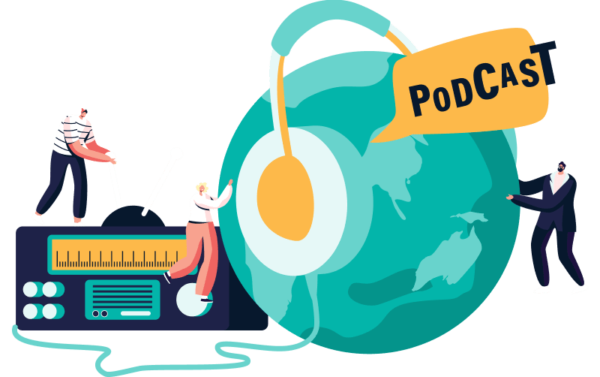 The bottom line
The bottom lineA successful podcast is all about the execution and the passion you put into it, so ultimately, let your enthusiasm be your guiding force. Where there’s a will there’s a way, so a strong desire to be a podcaster will carry you through the trials and tribulations you encounter along the way.
Any marketing tactic you undertake with genuine excitement and authenticity behind it will almost certainly yield success, so if you’ve been itching to get out your microphone and speak your truth, this is your sign to go for it!
Mackenzie Patterson is Quill Inc.’s digital content strategist.